Introduction
Imagine that when you step into a space, not only the walls and the ground, but also the ceiling above your head instantly comes alive, colorful and full of information.
This is no longer a scene from a science fiction movie, but a brand new visual experience brought by Affichage LED technology. This article will take you to a deeper understanding of the mystery of the ceiling LED display, revealing how it lights up the space with a unique perspective and reshapes your visual perception.
From technical analysis to application scenarios, from design aesthetics to future prospects, this article will present you with the charm of the ceiling LED display one by one.
You will learn how this technology breaks through traditional limitations and brings unprecedented changes to multiple fields such as business, public, and residential.
More importantly, through this article, you will discover how the ceiling LED display can create a more intelligent, interactive, and personalized space experience for you, making every visual contact a surprising discovery.
Now, let us embark on this journey of exploration together, unveil the mystery of the ceiling LED display, and feel the infinite possibilities it brings us!
1. What LED displays can be installed on the ceiling?
There are many types of LED displays that can be installed on the ceiling, mainly depending on the usage scenario, installation environment, and specific needs. Here are some common types of LED display screens suitable for installation on the ceiling:
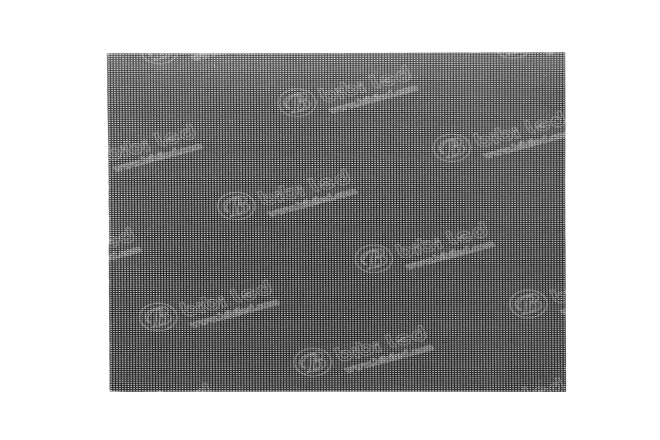
1). Indoor full-color LED display screen
Features: small light point, the display area can be several to more than ten square meters or even larger, moderate brightness, wide viewing angle, suitable for close viewing.
Application scenarios: mainly used in indoor halls, barres, étapes, performance halls, aéroports, theaters and other places that require high-definition display and rich colors.
Installation method: can be suspended or embedded to better integrate into the indoor environment.
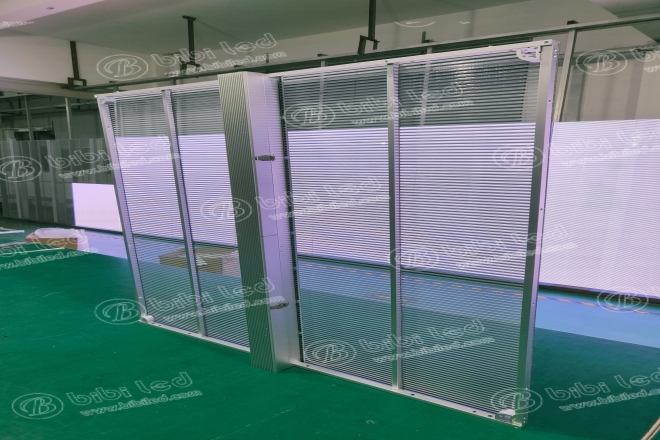
2). Écran d'affichage LED transparent
Features: It has high transparency and does not affect indoor lighting. It can also play videos, pictures, and other information.
Application scenarios: suitable for installation in centre commercial ceilings, glass curtain walls and other locations to achieve a perfect combination of advertising display and indoor lighting.
Installation method: depending on the specific environment, it can be suspended, wall-mounted, or embedded.
3). Special-shaped LED display screen
Features: various shapes can be customized according to the shape of the ceiling or design requirements.
Application scenarios: suitable for places that pursue personalized and artistic decorative effects, such as entertainment venues, art exposition halls, etc.
Installation method: According to the specific shape and size of the special-shaped screen, the corresponding hoisting, hanging or embedded installation method is adopted.
2. Which places will have LED screens installed on the ceiling?
LED screens are widely used on the ceilings of various places to provide information display, atmosphere creation, or enhanced experience. The following is a detailed classification and specific applications:
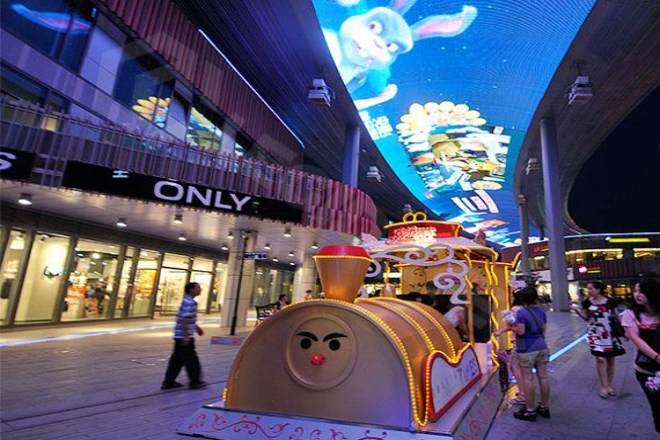
1). Commercial space
LED screens are installed on the ceilings of shopping centers, mainly used as guide systems and advertising display platforms. These screens can guide customers to find target stores, while displaying various promotional information and brand advertisements, effectively enhancing customers’ shopping experience.
- Restaurants and barres:
Installing LED screens on the ceilings of restaurants and bars can create a unique atmosphere and display special dishes, drinks or event information. This method not only improves the grade of restaurants and bars, but also increases the interactivity and participation of customers.
- Exposition venues:
LED screens are installed on the ceilings of exhibition venues, which can dynamically display exhibit information, company introductions, or event processes. This display method makes the exhibition more vivid and interesting and improves the audience’s participation and interactivity.
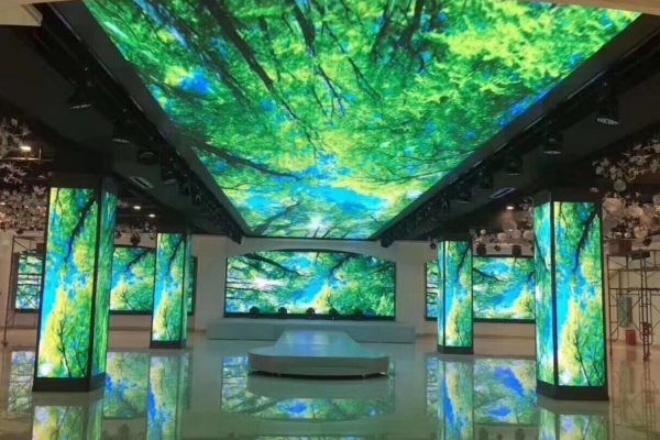
2). Public Space
- Aéroport Station:
In public spaces such as airport and station lounges, waiting halls, etc., LED screens are often installed on the ceiling to provide practical information such as flight information and train schedules.
This not only facilitates passengers’ travel arrangements but also improves the operating efficiency of the public transportation system.
- Musée Art Gallery:
LED screens can also be installed on the ceilings of museums and art galleries as an auxiliary means of displaying artworks. These screens can play videos, pictures, or text introductions related to the exhibits, providing the audience with a richer viewing experience.
LED screens installed on the ceilings of stadiums can play real-time game information, score updates, and sponsor advertisements. This display not only enhances the viewing experience of the audience on site but also enhances the commercial value and brand image of the venue.
3). Living Space
- Home Theater:
Installing LED screens on the ceilings of home theaters can create an immersive viewing experience. The audience can lie on the sofa, look up to see clear pictures and shocking sound effects and enjoy the fun of movies.
- Maison intelligente :
With the development of smart homes, LED screens are also increasingly used in living spaces. In the smart home system, the LED display screen on the ceiling can be used as an information display center, integrating multiple functions such as weather forecasts, family schedules, security monitoring, etc., to provide residents with a more convenient and intelligent life experience.
3. Precautions for installing LED display screens on the ceiling
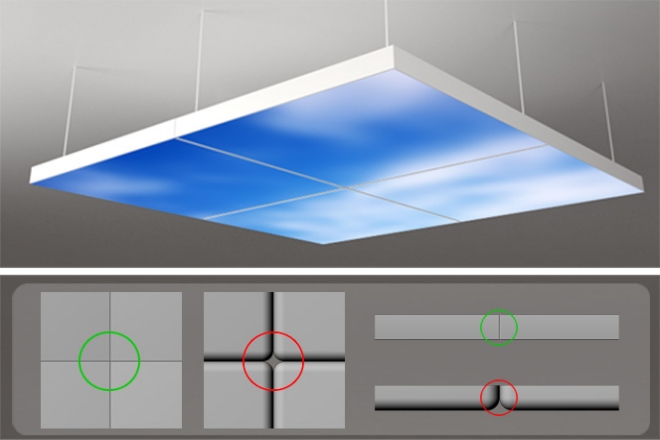
When installing LED display screens on the ceiling, you need to pay attention to multiple aspects to ensure the safety, stability, and display effect of the installation. Here are some key considerations:
1). Préparation préliminaire
- Load-bearing capacity assessment:
The first task is to assess the load-bearing capacity of the ceiling to ensure that it can safely support the weight of the LED display screen. This usually requires on-site measurement and calculation by professional engineers or technicians.
- Adaptabilité environnementale :
Consider factors such as temperature, humidity, ventilation, etc., in the environment where the ceiling is located to ensure that the LED display screen can work normally under these conditions.
- Design planning:
According to actual needs and usage scenarios, reasonably plan the size, résolution, luminosité and other parameters of the LED display screen, and design a suitable installation plan.
2). Installation process
- Fix the mounting frame:
Select a suitable mounting frame and fix it according to the actual situation of the ceiling. The mounting frame should be stable and reliable and be able to withstand the weight of the display screen and external factors such as wind.
Use appropriate tools and materials to ensure the fixing effect of the mounting frame.
- Connect the power and signal cables:
Connect the power cable of the LED display to the power socket to ensure that the power supply is stable and reliable. During the connection process, pay attention to the direction and fixation of the wires to avoid squeezing or damage.
Connect the signal cable of the display to the computer or other control equipment to ensure stable and interference-free signal transmission. Choose the appropriate signal cable interface type and length to ensure the quality of the connection.
- Heat dissipation:
The LED display will generate a certain amount of heat during operation, so heat dissipation needs to be considered. Ensure that there is enough ventilation space around the display to avoid being blocked by other equipment.
You can install a cooling fan or adopt other heat dissipation measures to improve the heat dissipation effect of the display.
3). Debugging and testing
- Debugging the display:
After the installation is completed, the LED display needs to be debugged to check whether its display effect, brightness, contrast, and other parameters are normal.
During the debugging process, pay attention to adjusting the display angle and position of the display to ensure that the audience can get the best viewing effect.
- Test de stabilité :
Test the stability and reliability of the display to ensure that it can operate stably for a long time. Check whether the connection of the power cable, signal cable, etc. is firm and reliable to avoid loosening or falling off.
Level detection: For LED display screens installed on the ceiling, a level detection must be performed after installation. Ensure that the level of both ends of the display screen does not exceed the specified range (such as 5mm) to ensure the consistency of the display effect.
4). Post-maintenance
- Contrôle régulier :
After installation, the LED display screen should be inspected and maintained regularly. The inspection content includes whether the power cord and the signal line are loose or damaged, whether there are bright spots or dark spots on the display screen, etc.
Clean the dust and dirt on the surface of the display screen to keep it clean and beautiful.
- Entretien professionnel :
For large or complex LED display screen systems, it is recommended that a professional maintenance team perform regular maintenance and maintenance. They have professional knowledge and skills to detect and solve problems in a timely manner.
4. Problems and solutions for ceiling-mounted LED display screens
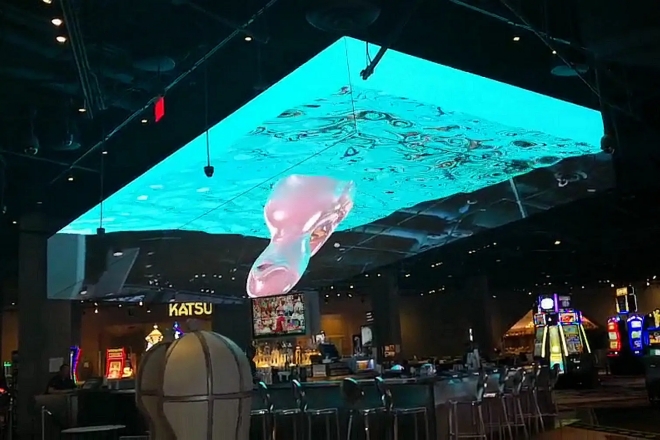
1). Problem description: LED display screens generate a lot of heat when working. If the heat dissipation is poor, it will affect the life and display effect of the display screen.
- Solution:
Ensure that there is enough ventilation space on the ceiling so that the heat can be dissipated smoothly.
Install a cooling fan or adopt other heat dissipation measures, such as heat sinks, heat pipes, etc., to improve the heat dissipation effect of the display screen.
Regularly check the working status of the cooling system to ensure its normal operation.
2). Problem description: Large LED display screens are heavy, which places higher demands on the load-bearing capacity of the ceiling.
- Solution:
Perform a strict load-bearing assessment before installation to ensure that the ceiling can bear the weight of the display screen.
Use professional mounting brackets and fixtures to ensure that the display screen is firmly installed on the ceiling.
Regularly check the status of the mounting brackets and fixtures to prevent loosening or falling off.
3). Problem description: Ceiling-mounted LED display screens require professional technology and equipment, and the installation process is complicated and time-consuming.
- Solution:
Employ a professional installation team with rich experience to install and ensure the quality and safety of the installation.
Make adequate preparations before installation, including measuring dimensions, planning layout, and preparing materials.
Follow the installation instructions and operating procedures to ensure a smooth installation process.
Conclusion
With the continuous advancement of science and technology and people’s continuous pursuit of quality of life, ceiling LED display screens, as an innovative spatial visual solution, are gradually showing their immeasurable potential and value.
It not only brings unprecedented visual experience to commercial spaces, public areas and even residential environments, but also becomes an important force to promote space design innovation and improve the quality of life with its unique artistic expression and information communication capabilities.
Enfin, si vous souhaitez en savoir plus sur les écrans LED, veuillez nous contacter.
